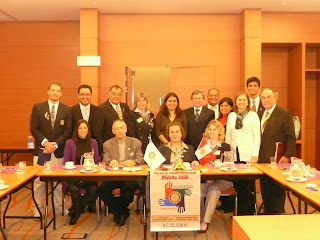The conference represents the pinnacle of a district governor's year, celebrated together with a special representative of the President of Rotary International. It provides an opportunity for discussion of key needs in the community and larger society as well as the projects the various clubs are working on -- and of course a chance for Rotarians from different clubs to become better acquainted.
We arrived on Friday in time to relax a bit before the opening dinner, where we heard from Rotary leaders at many levels as well as a representative from the nonprofit group Agua Limpia, which works together with governments and other groups to ensure the sustainability of their water projects.
On Saturday, we took advantage of both the local industry (Ica is wine and pisco country) and terrain (sand dunes, desert) as we visited a local vineyard in the morning and went sandboarding at sunset.

There was quite a bit of wind up at the top and the sand curled in waves and burned a little as it hit our skin. But we had an incredible view from up there (see our hotel below) and had a lot of fun learning the ropes of sandboarding and getting some practice in.
And then Sunday morning we woke up to make another presentation, pack up our things, and head back to Lima to meet our new host families... And now begins our last week. Incredible how time flies.



















































